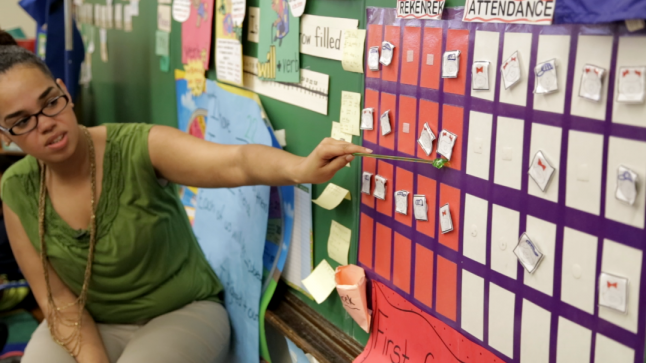Series: About the Collaborative
Learning Lab Marks Finale of Innovations Program

Tuesday, June 23, 2015 marked the date of the last day of learning for the Innovations program, which concluded after four years of intensive math professional development. Teachers from the seven schools involved in the program came together to think deeply about early math concepts in a final learning lab, the last of over 15 throughout the program’s duration.
“We create a safe space, where teachers can really begin to wrestle with what they do and don’t understand about math,” says Donna Johnson, Teacher Support Services Coordinator.
This learning lab was unique in that the presentations were led almost entirely by teachers from Innovations schools.
Teachers from one such school, Gale Elementary, led a session about using a rekenrek-styled chart while taking morning attendance. Students are encouraged to discover efficient ways to answer “How many children are here today?” At the beginning of the year, they might use counting by ones as the strategy to respond to this question. As they explore the structure of the rekenrek counting rack tool, however, they begin to unitize and count by fives and tens. This daily routine gives students the opportunity to practice subitizing and gradually builds important numerical relationships at the core of number sense.
Teachers from another school, Reinberg Elementary, explained a strategy that has made a significant difference in how their students approach word problems. Students who struggle with these types of problems will often begin to operate on the numbers before they fully understand the story behind the problem. The Three Read Protocol encourages them to read through the problem three times, focusing on different aspects of the problem each time: first the context, then the mathematics, and finally the question. It focuses attention on understanding problems rather than getting answers and allows for natural differentiation within a class of diverse learners.
In another session, four teachers from Lorca Elementary described their ongoing cycle of cross-grade collaboration. They explained how teachers from different grade levels meet regularly to select and plan a Number String Math Talk with optimal student learning trajectories in mind. As one member of the team teaches the Math Talk, the other teachers observe. Later, they meet to debrief evidence of student learning as well as the teacher moves that supported or obstructed learning. This session exemplifies the kinds of learning communities that have been established in our sister schools where ongoing, teacher-led professional development is taking place.

NOTE: Videos of these strategies in action will be coming out in the near future.
From the beginning of Innovations, learning labs were meant to shine a light on the way teachers think about early math education.
“We try to engage them as adult learners, so they experience math in a new way,” says Assistant Director of Programming, Jeanine Brownell.
Often this involves taking a fundamental math concept—counting or shapes, for example—and giving it a twist. Learning lab participants might be asked to solve problems while working within an unfamiliar number system, for example, or build a 3D shape out of its 2D faces.
K. Christopher Anderson, who taught at Innovations sister school Manierre Elementary, contends that this sort of thinking put teachers in the shoes of their students: “It kind of mimicked going through the process as a three- or four-year old learning a number system for the first time.”
Although Innovations is coming to an end, the hope is that teachers will continue to set aside time for Grade Level Meetings devoted to planning and reflecting on their math instruction.
“The long-term goal,” Brownell explains, “is to help teachers internalize these teaching practices, so that even without a coach in the room, the teacher is being very reflective and intentional.”
Innovations began in 2010 and, in addition to learning labs, it provided in-person coaching, facilitated grade-level meetings, and analysis of lessons through online and video support for over 120 teachers in Chicago Public Schools. The Innovations program was funded through a $5 million grant from the U.S. Department of Education Investing in Innovation (“i3